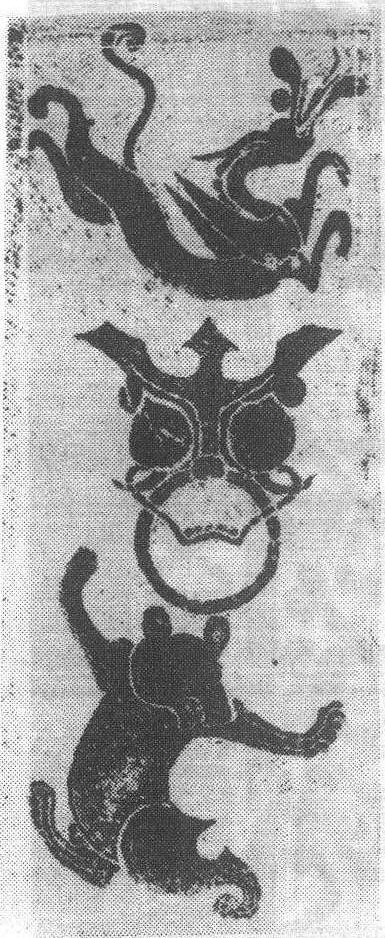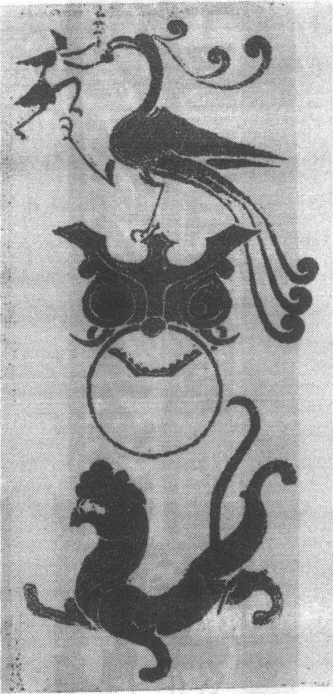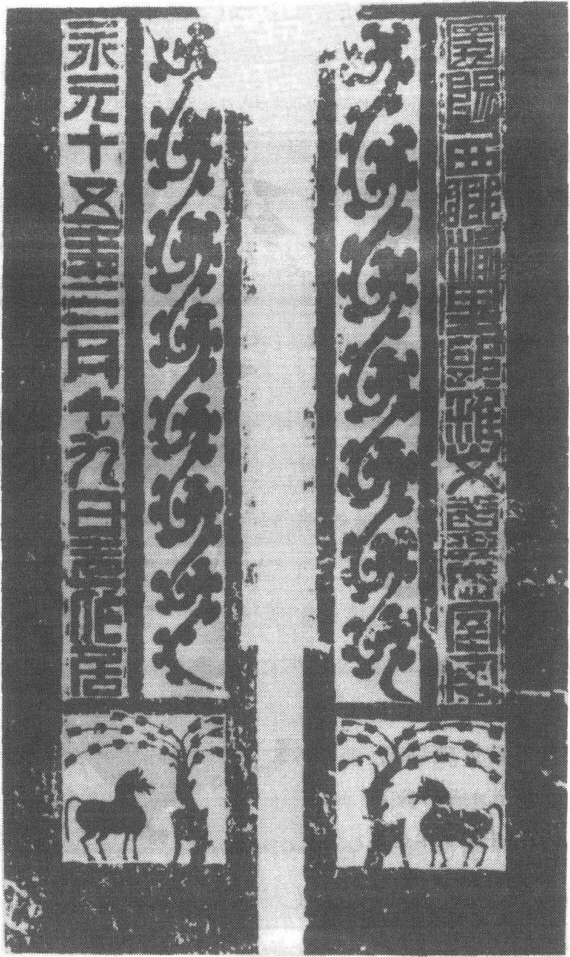Chapter 10 Chapter 10 Paintings on Rocks - Petroglyphs and Pictorial Stones
Rock paintings include two aspects: one is to use natural stone cliffs to depict, commonly known as petroglyphs; the other is to use artificial stones to paint, mainly including portrait stones.A long time ago, the ancestors used knives to paint on natural cliffs or caves.Most people call this kind of painting cliff painting or petroglyph.
In my country, in the "Shui Jing Zhu" written by Li Daoyuan of the Northern Wei Dynasty, it is mentioned that there are many rock paintings on both sides of the Yellow River, the Yangtze River and other major rivers; the rock paintings in Hua'an, Fujian Province are said to have been discovered in the Tang Dynasty; Rock paintings have been recorded in books such as "Continued Museum History" by Li Shi in the Song Dynasty, and "Strange Records" by Zhang Mu in the Ming Dynasty.According to the investigation of cultural relics and archaeologists, my country's rock paintings are widely distributed in Heilongjiang, Jilin, Inner Mongolia, Xinjiang, Gansu, Ningxia, Sichuan, Yunnan, Tibet, Guangxi, Jiangsu, Zhejiang, Fujian and other provinces, autonomous regions and cities. Concentrated in the north, northwest and southwest.
In 1979, in Zhuozi Mountain, Haibo Bay, Inner Mongolia Autonomous Region, an old shepherd poked the sand with a whip, and suddenly discovered the picture buried under the sand.After cleaning up, several petroglyphs were found on this slope, although the area was not very large, but the pictures were very dense, most of which were human faces.According to investigations, this place was probably the place where the ancestors worshiped their ancestors. This is the place where the most concentrated human face petroglyphs have been discovered in my country.In the picture, strange human faces look up at the vast blue sky, as if they are telling the grand occasion of the ceremony in the past and the desolation of the current situation, which makes people have infinite reverie.
In the Altai Mountains, a well-known international mountain system connecting Mongolia and Russia in the northwest of my country, Chinese cultural relics and archaeologists have discovered that there are intermittent ancient petroglyph corridors about 1,000 kilometers long hidden in the mountains, and more than 40 painting spots have been found. There are more than 10,000 rock paintings.This is the largest group of petroglyphs discovered so far in my country, and occupies an important position in the petroglyph belt of the grasslands in northern Asia.The petroglyphs in the Altai Mountains of China were discovered in 1982, and a comprehensive scientific investigation began in 1983.After five years of work, the expedition traveled tens of thousands of miles and obtained a large amount of first-hand materials.It was found that this “corridor” of petroglyphs stretches from Qinghe County in the east, which is now my country’s border with Mongolia, to Habahe County and Jimunai County in the west, which are adjacent to Russia. It is distributed in the deep valleys of 18 villages in seven counties and cities. Most of the places are the passages of the ancestors when they were nomadic.According to analysis, the rock paintings in the Altai Mountains were created in different periods. The earliest works may have come from the "Sai people" in the pre-Qin period, and the later works were made by the Turkic and Khitan people after the Tang Dynasty.The petroglyphs are very rich in content, some express the ancient social life, or depict the scene of long-standing group marriage system; some express the joy after labor, or recall the fierce struggle between tribes; Animal images (such as dromedary camels, etc.).These petroglyphs are not only loved by artists, but also are precious materials for studying the ecological changes of the Altai region and the grasslands of Northwest China as a whole.Because the petroglyphs in this area have many commonalities in themes and creation methods with the rock paintings in Yinshan, Inner Mongolia, Mongolia, and Siberia, Russia, etc., it is very important for the study of the causes, formation process and content characteristics of the northern Asian steppe rock paintings. is of great significance.
In recent years, cultural relics and archaeologists of Ningxia Hui Autonomous Region discovered ancient petroglyphs at the eastern foot of Helan Mountain, which is one of the important rock paintings in Northwest China.It stretches more than 500 kilometers from north to south, with more than 10 painting spots and more than a thousand petroglyphs.Helan Mountain is in the west of the Yinchuan Plain, with lush water and grass. Since ancient times, it has been the place where nomadic peoples such as the Huns, Qiang, Xianbei, Turks, Tubo, Dangxiang, and Mongolia have been active. They have left many precious relics here, and rock paintings are one of them. .These petroglyphs are rich in content and reproduce the social form, living customs and religious beliefs of ancient nomadic peoples.These petroglyphs provide extremely precious material materials for the study of the development history of the ancient northern minorities.
Since the 1960s and 1970s, 10 petroglyphs have been discovered in Cangyuan Wa Autonomous County, Yunnan Province, which borders my country and Myanmar.From these petroglyphs, 1063 images can be identified, including 785 figures, 187 animals, 25 houses, 13 roads, and 35 various ideograms.It mainly depicts the life scenes of the local residents transitioning from hunting to domestication at that time, but the scenes that specifically reflect agricultural production and animal husbandry have not yet been identified.The housing is "dry column" style, and the village is composed of several stilt-style houses. The architectural form has obvious characteristics of the southern people.The age of these rock paintings is preliminarily believed to belong to the Neolithic Age, about 3,000 years ago.The rock paintings in Cangyuan are the earliest rock paintings discovered in my country, which provide a valuable image material for the study of national history, primitive society history and art history in our country.
A common feature of rock paintings in our country is that they are depicted earlier, and most of them are ethnic minorities who are relatively backward in production.In the vast areas of the Han nationality, stones processed by humans are mainly used for painting. This kind of painting is called pictorial stone, which basically appeared at the same time as stele inscriptions, and appeared later than petroglyphs. It can be regarded as the second stage of stone carvings in my country.Compared with petroglyphs, portrait stones are very different, not only in terms of region, maker, time, artistic level, etc., but also in terms of productivity level and social development stage.
The so-called pictorial stones mainly refer to stone carvings in which the images are inscribed with plane lines.Regardless of the nature of their content, such stone carvings can technically be classified as portrait stones.The appearance and use of stone reliefs in our country were mainly in the Han Dynasty.Why is there a portrait stone at this time?In a word, there may be two reasons: (1) mature stone carving technology; (2) social needs.
This situation can be illustrated by taking the stone reliefs in Shandong as an example.According to preliminary information, stone reliefs have been unearthed in more than 60 counties in Shandong Province, accounting for more than half of the total number of counties in the province, but the distribution is uneven, mainly in the southern Shandong area and Linyi area; Tai'an, Jinan, and Changwei areas have also been found; There are only a few unearthed in Southwest Shandong, Jiaodong and other places.
The reason why there are many portrait stones in the southern Shandong area is that the area is located in a mountainous area, with many not-so-high hills and rich stone materials, which provide rich raw materials for the production of portrait stones, thus creating a batch of stone carvings for the use of stone materials. A group of stone carving craftsmen prepared technical strength for portrait stone carving.Secondly, the southern Shandong area is a place with developed economy and culture in history. Before the Qin Dynasty, it was the famous Qilu State. In addition, this area belongs to the Wen, Si, Yi, and Shu river basins. The land is fertile, the water conservancy is developed, and iron smelting The production of handicrafts such as cooking, cooking salt, and textiles is relatively advanced, so the feudal economy in these areas has developed rapidly.Zhong Changtong of the later Han Dynasty said that here, "the house of the rich has hundreds of buildings, thousands of servants and maidservants, and thousands of them. Boats and carts are sold in all directions; the waste of the king's savings is full of the capital. Qi bribes treasures and rich houses. It cannot be tolerated; horses, cattle, sheep and hogs, and valleys cannot be tolerated." ("Book of the Later Han·Zhong Chang Tong Biography").These words are exaggerated, but it is a fact that the economy here is relatively developed, which provides material conditions for the engraving of stone reliefs.At the same time, there are also such requirements in political ideology. Advocating Confucian filial piety and the style of lavish burials are the direct motives for the production of stone portraits.
Since the appearance of stone portraits is closely related to the advocacy of filial piety and the style of generous burials, stone reliefs are mainly used in the construction of tombs for burying the dead and ancestral halls built on the ground.
The stone reliefs in the Han Dynasty are widely distributed, ranging from today’s Beijing in the north to Mizhi and Yulin in northern Shaanxi in the northwest, Chengxian County in Gansu in the west, Zhaotong in Yunnan in the southwest, Dangyang on the north bank of the Yangtze River in the south, and Haining in Zhejiang Province on the north bank of Hangzhou Bay in the southeast. , east to Muping, Shandong Peninsula.Among them, Shandong, Xuzhou and Xinhailian in northern Jiangsu, Nanyang in Henan, Xiangfan in Hubei, northern Shaanxi and central Sichuan are the most concentrated.Its contents can be grouped into four categories:
(1) Social reality category, which reflects the production and living conditions at that time;
(2) Myths, including myths and legends, immortals and ghosts, strange birds and monsters, etc.;
(3) Stories of historical figures, including famous ancient emperors and generals, sages, filial sons and martyrs, assassins, etc.;
(4) Natural scenery, including the sun and the moon, stars, clouds, mountains, rivers, trees, etc.
Pictorial stones have extremely important reference value for us to understand the social life, production conditions, ideology, customs, sculpture art, etc. of the Han Dynasty.Here are one or two examples of such portraits.
"Portrait of Wu's Ancestral Hall".Wu's Ancestral Hall is the general term for the ancestral halls built in the Wu family cemetery in the Han Dynasty, including Wurong Ancestral Hall, Wuliang Ancestral Hall, Wu Kaiming Ancestral Hall, Wuban Ancestral Hall, etc.The temple is located at the northern foot of Wuzhai Mountain (Wuzhai Mountain) in Jiaxiang County, Shandong Province.According to the inscription on the ancestral hall, in the late Eastern Han Dynasty, the Wu family in Jiaxiang was an official for generations. In the first year of Emperor Huan's Jianhe (AD 147), his descendants began to build the Wu family's ancestral hall in front of the tomb, and it took decades to complete.There are stone towers, stone lions, tombstones and portraits in the temple.There are still more than 40 stone portraits in existence.The contents of the stone portraits are mostly historical figures, historical stories, stories of filial piety, stories of martyrs, myths and legends, and various car and horse trips, feasts and dances, water and land attacks, auspicious disasters, animals, etc., reflecting the social conditions at that time from different angles , customs, laws and regulations and religious beliefs.It is not only an exquisite stone carving artwork, but also an important historical material for studying the politics, economy and culture of the Eastern Han Dynasty.

"Portraits of Yinglong, Pushou, and Bear in Fangcheng, Henan Province" is collected from "The Complete Works of Chinese Art" painting compilation 18 volumes, Shanghai People's Fine Arts Publishing House, 1988 edition

"Portrait of Suzaku, Pushou, and White Tiger in Fangcheng, Henan Province" (Eastern Han Dynasty) is collected from "The Complete Works of Chinese Art" painting compilation 18 volumes, Shanghai People's Fine Arts Publishing House, 1988 edition

"Portrait Stones of the Han Dynasty Tomb in Wulidian, Suide, Shaanxi" (Eastern Han Dynasty) is collected from "The Art of Calligraphy in the Forest of Steles in Xi'an", Shaanxi People's Fine Arts Publishing House, 1983 edition
"Dawenkou Portrait Stone Tomb". It was discovered in Tai'an, Shandong in 1960. In 1984, the unearthed portrait stone was transported to Tai'an Dai Temple for display.Built in the late Eastern Han Dynasty, the tomb is mainly made of stone. The plane is in an inverted convex shape.It is about 6 meters long from north to south, and 4.65 meters wide from east to west (south end) to 6.4 meters (north end).Among them, there are nine portrait stones, mainly on the lintel and central pillars.The contents of the portraits include portraits of people, traveling with horses and chariots, stories of dutiful sons, historical stories, etc.

"Portraits of Yinglong, Pushou, and Bear in Fangcheng, Henan Province" is collected from "The Complete Works of Chinese Art" painting compilation 18 volumes, Shanghai People's Fine Arts Publishing House, 1988 edition

"Portrait of Suzaku, Pushou, and White Tiger in Fangcheng, Henan Province" (Eastern Han Dynasty) is collected from "The Complete Works of Chinese Art" painting compilation 18 volumes, Shanghai People's Fine Arts Publishing House, 1988 edition

"Portrait Stones of the Han Dynasty Tomb in Wulidian, Suide, Shaanxi" (Eastern Han Dynasty) is collected from "The Art of Calligraphy in the Forest of Steles in Xi'an", Shaanxi People's Fine Arts Publishing House, 1983 edition
